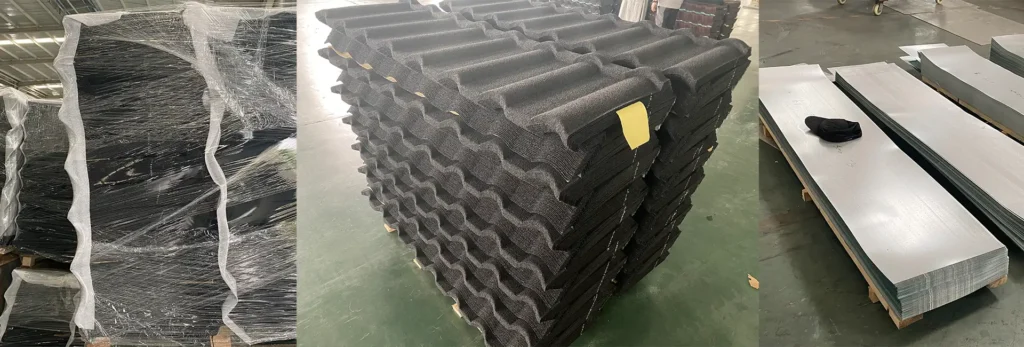1. What are Stone Coated Metal Roofing Tiles?
Stone coated metal roofing tiles are a new type of composite roofing material. They use metal as the base material, with their surface covered by specially treated natural colored stone particles. Combining the strength of metal and the aesthetics of stone, they are widely used for roof decoration and protection in various buildings.

2. Historical Development
The origin of stone coated metal roofing tiles can be traced back to the mid-20th century in Europe and the United States. At that time, traditional roofing materials (such as ceramic tiles and asphalt shingles) had issues like heavy weight, short lifespan, and high maintenance costs, prompting the industry to explore composite structures of “metal base + surface decorative layer.”
- Early stage (1950s-1960s): Ordinary steel plates were used as the base material, with colored coatings sprayed on the surface. However, they had poor weather resistance, being prone to fading and rusting.
- Technological breakthroughs (1970s-1980s): Galvalume steel was developed as the base material, significantly improving corrosion resistance. Meanwhile, a surface layer combining natural stone particles and resin was introduced, solving the problem of paint fading. This greatly enhanced the durability and aesthetics of stone coated metal roofing tiles.
- Global promotion (1990s-present): With matured craftsmanship, the product gradually gained global popularity, especially in regions with diverse climates (rainy, snowy, or strong ultraviolet conditions). In recent years, market demand has grown rapidly in Asia (such as China and Japan).
3. Raw Material Composition
Stone coated metal roofing tiles have a multi-layer composite structure, with each layer’s materials and functions as follows:
- Base material layer: The core is a galvalume steel sheet (0.3-0.5mm thick), consisting of an alloy coating of 55% aluminum, 43.3% zinc, and 1.6% silicon. It provides high strength and corrosion resistance (3-5 times more corrosion-resistant than ordinary galvanized steel plates).
- Primer layer: An acrylic resin primer that enhances adhesion between the base material and the surface layer, preventing delamination.
- Colored stone layer: Crushed particles of natural basalt or granite (1-3mm in particle size), colored through high-temperature sintering. They combine color stability and wear resistance, giving the tiles a stone-like texture.
- Protective layer: A transparent acrylic resin coating covering the colored stones, improving water resistance and UV resistance, and reducing the falling off of colored stones.
4. Core Features
- Strong durability: The base material is corrosion-resistant, and the surface colored stones are aging-resistant, with a service life of over 50 years—far exceeding traditional asphalt shingles (10-15 years) and ceramic tiles (20-30 years).
- Resistance to extreme weather:
- Wind resistance: Lightweight (about 7-10kg/㎡), it can resist strong winds of 120-150km/h after installation (traditional ceramic tiles, weighing 40-60kg/㎡, are easily blown off by strong winds).
- Weather resistance: Stable performance under temperature differences from -40℃ to 80℃, and can withstand hail impacts with a diameter of less than 2.5cm.
- Fire resistance: The base material is metal, and the surface colored stones are non-combustible, reaching the highest building fire rating (Class A) overall.
- Aesthetic diversity: The surface colored stones can imitate the textures of slate tiles, ceramic tiles, asphalt shingles, etc. With colors covering dozens of types (such as red, green, gray, brown), they adapt to different architectural styles (Chinese, European, modern).
- Lightweight: Weighing only 1/5 to 1/6 of traditional ceramic tiles, it reduces the load pressure on the building roof, making it especially suitable for old building renovation (no need for additional structural reinforcement).
- Energy efficiency: The surface colored stones and resin layer can reflect part of solar radiation, reducing heat absorption by the roof. In summer, it can lower indoor temperatures by 3-5℃, indirectly saving air conditioning energy consumption.
5. Advantages and Disadvantages
Advantages:
- Long service life and low maintenance cost (almost no need for regular replacement).
- Excellent performance in wind resistance, fire resistance, hail resistance, etc., adapting to complex climates.
- Lightweight, reducing building structural load and facilitating easy installation.
- Rich colors and high aesthetics, enhancing the added value of buildings.
- Environmental protection: The base material is recyclable, the colored stones are natural materials, and there are no harmful substances such as formaldehyde.
Disadvantages:
- High initial cost: The unit price is about 2-3 times that of asphalt shingles and 1.5 times that of ceramic tiles, requiring a large initial investment.
- High installation requirements: Professional teams are needed for construction (such as sealing treatment and fixing methods); otherwise, water leakage and tile loosening may occur.
- Noise issue: During rain, the metal base material may produce certain noises (which can be alleviated by adding a sound insulation layer).
- Difficulty in repairing local damage: If a single tile is damaged, it needs to be replaced entirely (the colored stone layer cannot be partially repaired); otherwise, water resistance will be affected.
In summary, stone coated metal roofing tiles are suitable for building scenarios with high requirements for roof service life and weather resistance, and sufficient budgets (such as villas, clubs, large public buildings, etc.).



